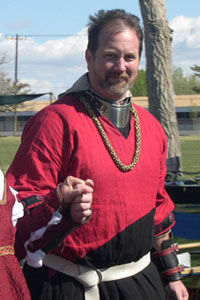 A sonnet shows two related but differing things to the reader, in order to communicate something, told in iambic pentameter. There are different kinds of sonnets. In this Petrarchan Sonnet, the first eight lines give details of the battle as seen by bystanders; the last six lines offer a glimpse into the heart of the consort.
A sonnet shows two related but differing things to the reader, in order to communicate something, told in iambic pentameter. There are different kinds of sonnets. In this Petrarchan Sonnet, the first eight lines give details of the battle as seen by bystanders; the last six lines offer a glimpse into the heart of the consort.
The Petrarchan Sonnet is divided into two sections by two different groups of rhyming sounds. The change from one rhyme group to another signifies a change in subject matter.
The first eight lines is called the octave and rhymes:
a b b a a b b a
The remaining six lines is called the sestet and can have either two or three rhyming sounds, arranged in a variety of ways; in my sonnet:
c d e c d e
————-<>————-
Sir Gamyl of Mottrum
fallen in Fall Crown Tourney, A.S. XLII
(Petrarchan Sonnet)
The lion took the field to meet his foe;
Both wolf and wyvern fell against him there
Before another knight would feel despair.
And when this day had ended, all would know.
Two lions stood at ready, armed to go
Until one would become Ithuna’s heir.
The hammer fell; defeat was in the air;
For python was to strike the final blow.
These contests, on this day, did best impart
The glory lauded from a lover’s eyes
On to the field of valor where he lay.
His victory, she knew within her heart.
The battle lost, but chivalry the prize;
To fall, then rise with honor on this day.
–THL Beathog nic Dhonnchaidh
. . . is a 14th century bard who can often be seen traveling far from her home in the Highlands with her lord husband and muse. If a good tale crosses her path, she will sing a song about it, pull out its hair and spin it, or throw it in a pot and cook it up.
